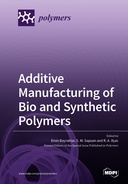Explore

Additive Manufacturing of Bio and Synthetic Polymers
0 Ungluers have
Faved this Work
Login to Fave
Additive manufacturing technology offers the ability to produce personalized products with lower development costs, shorter lead times, less energy consumed during manufacturing and less material waste. It can be used to manufacture complex parts and enables manufacturers to reduce their inventory, make products on-demand, create smaller and localized manufacturing environments, and even reduce supply chains. Additive manufacturing (AM), also known as fabricating three-dimensional (3D) and four-dimensional (4D) components, refers to processes that allow for the direct fabrication of physical products from computer-aided design (CAD) models through the repetitious deposition of material layers. Compared with traditional manufacturing processes, AM allows the production of customized parts from bio- and synthetic polymers without the need for molds or machining typical for conventional formative and subtractive fabrication.In this Special Issue, we aimed to capture the cutting-edge state-of-the-art research pertaining to advancing the additive manufacturing of polymeric materials. The topic themes include advanced polymeric material development, processing parameter optimization, characterization techniques, structure–property relationships, process modelling, etc., specifically for AM.
This book is included in DOAB.
Why read this book? Have your say.
You must be logged in to comment.
Rights Information
Are you the author or publisher of this work? If so, you can claim it as yours by registering as an Unglue.it rights holder.Downloads
This work has been downloaded 108 times via unglue.it ebook links.
- 108 - pdf (CC BY) at Unglue.it.
Keywords
- 3D printing
- ABS
- additive technologies
- antibacterial
- anticancer activity
- antimicrobial
- antimicrobial properties
- bio-based polyethylene composite
- bio-based polymer
- biocomposite
- biodegradable polymers
- biopolymer
- blend
- building orientation
- carbon fibres
- CNT
- composite
- composite material
- Design Process
- Drug delivery
- dust cloud
- dust explosion
- epoxidized jatropha oil
- extrusion
- Fatigue
- fibre treatment
- flexible TPU
- food packaging
- fused deposition modelling (FDM)
- fused filament fabrication
- fused-filament fabrication
- high-density polyethylene
- History of engineering & technology
- internal architecture
- jatropha oil
- kenaf
- kenaf fibre
- lattice material
- layer thickness
- Mechanical properties
- mechanical strength
- minimum ignition temperature of dispersed dust
- MWCNT
- naked mole-rat algorithm
- natural bioactive polymers
- natural fiber composite
- natural fibres
- non-covalent functionalisation
- nozzle size
- optimization
- P3HT
- pitch
- polyamide 12
- polyethylene
- polylactic acid (PLA)
- polymeric scaffolds
- polythiophene
- process parameters
- Product design
- reaction time
- shape memory polymer
- silver nanopowder
- sustainability design
- Technology, engineering, agriculture
- Technology: general issues
- Thermal properties
- thermo-mechanical loads
- thermoplastic starch
- Tissue Engineering
- X-ray tomography
Links
DOI: 10.3390/books978-3-0365-3319-3Editions

